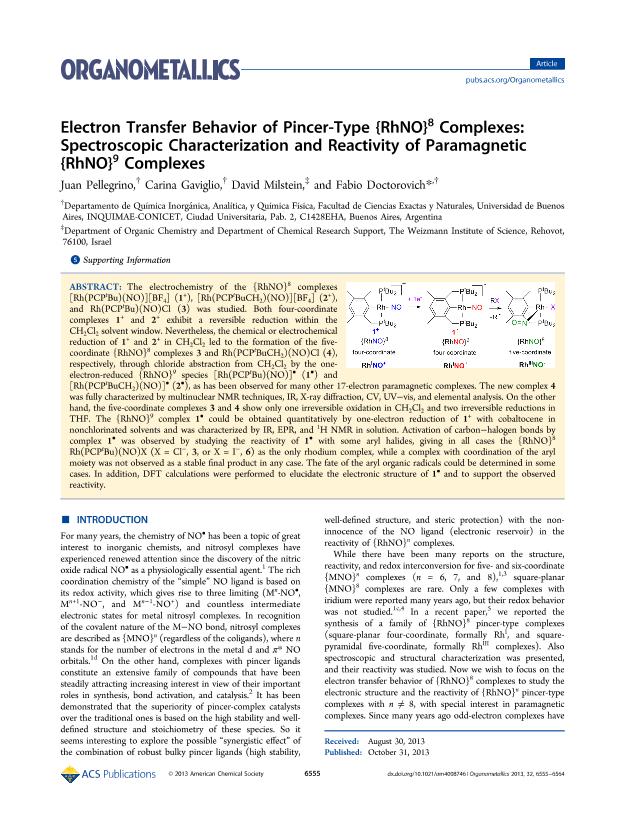Mostrar el registro sencillo del ítem
dc.contributor.author
Pellegrino, Juan

dc.contributor.author
Gaviglio, Carina del Valle

dc.contributor.author
Milstein, David
dc.contributor.author
Doctorovich, Fabio

dc.date.available
2016-11-09T21:18:28Z
dc.date.issued
2013-10-31
dc.identifier.citation
Pellegrino, Juan; Gaviglio, Carina del Valle; Milstein, David ; Doctorovich, Fabio; Electron transfer behavior of pincer-type {RhNO}8 complexes: Spectroscopic characterization and reactivity of paramagnetic {RhNO}9 complexes; American Chemical Society; Organometallics; 32; 21; 31-10-2013; 6555-6564
dc.identifier.issn
0276-7333
dc.identifier.uri
http://hdl.handle.net/11336/8111
dc.description.abstract
The electrochemistry of the {RhNO}8 complexes [Rh(PCPtBu)(NO)][BF4] (1+), [Rh(PCPtBuCH2)(NO)][BF4] (2+), and Rh(PCPtBu)(NO)Cl (3) was studied. Both four-coordinate complexes 1+ and 2+ exhibit a reversible reduction within the CH2Cl2 solvent window. Nevertheless, the chemical or electrochemical reduction of 1+ and 2+ in CH2Cl2 led to the formation of the five- coordinate {RhNO}8 complexes 3 and Rh(PCPtBuCH2)(NO)Cl (4), respectively, through chloride abstraction from CH2Cl2 by the one-electron-reduced {RhNO}9 species [Rh(PCPtBu)(NO)]• (1•) and [Rh(PCPtBuCH2)(NO)]• (2•), as has been observed for many other 17-electron paramagnetic complexes. The new complex 4 was fully characterized by multinuclear NMR techniques, IR, X-ray diffraction, CV, UV−vis, and elemental analysis. On the other hand, the five-coordinate complexes 3 and 4 show only one irreversible oxidation in CH2Cl2 and two irreversible reductions in THF. The {RhNO}9 complex 1• could be obtained quantitatively by one-electron reduction of 1+ with cobaltocene in nonchlorinated solvents and was characterized by IR, EPR, and 1H NMR in solution. Activation of carbon−halogen bonds by complex 1• was observed by studying the reactivity of 1• with some aryl halides, giving in all cases the {RhNO}8 Rh(PCPtBu)(NO)X (X = Cl−, 3, or X = I−, 6) as the only rhodium complex, while a complex with coordination of the aryl moiety was not observed as a stable final product in any case. The fate of the aryl organic radicals could be determined in some cases. In addition, DFT calculations were performed to elucidate the electronic structure of 1• and to support the observed reactivity.
dc.format
application/pdf
dc.language.iso
eng
dc.publisher
American Chemical Society

dc.rights
info:eu-repo/semantics/openAccess
dc.rights.uri
https://creativecommons.org/licenses/by-nc-sa/2.5/ar/
dc.subject
Rhodium
dc.subject
Nitrosyl
dc.subject
Electrochemistry
dc.subject
Paramagnetic
dc.subject.classification
Química Inorgánica y Nuclear

dc.subject.classification
Ciencias Químicas

dc.subject.classification
CIENCIAS NATURALES Y EXACTAS

dc.title
Electron transfer behavior of pincer-type {RhNO}8 complexes: Spectroscopic characterization and reactivity of paramagnetic {RhNO}9 complexes
dc.type
info:eu-repo/semantics/article
dc.type
info:ar-repo/semantics/artículo
dc.type
info:eu-repo/semantics/publishedVersion
dc.date.updated
2016-10-25T19:27:43Z
dc.journal.volume
32
dc.journal.number
21
dc.journal.pagination
6555-6564
dc.journal.pais
Estados Unidos

dc.journal.ciudad
Washington
dc.description.fil
Fil: Pellegrino, Juan. Consejo Nacional de Investigaciones Científicas y Técnicas. Oficina de Coordinación Administrativa Ciudad Universitaria. Instituto de Química, Física de los Materiales, Medioambiente y Energía; Argentina. Universidad de Buenos Aires; Argentina
dc.description.fil
Fil: Gaviglio, Carina del Valle. Universidad de Buenos Aires; Argentina. Consejo Nacional de Investigaciones Científicas y Técnicas. Oficina de Coordinación Administrativa Ciudad Universitaria. Instituto de Química, Física de los Materiales, Medioambiente y Energía; Argentina
dc.description.fil
Fil: Milstein, David . The Weizmann Institute of Science; Israel
dc.description.fil
Fil: Doctorovich, Fabio. Consejo Nacional de Investigaciones Científicas y Técnicas. Oficina de Coordinación Administrativa Ciudad Universitaria. Instituto de Química, Física de los Materiales, Medioambiente y Energía; Argentina. Universidad de Buenos Aires; Argentina
dc.journal.title
Organometallics

dc.relation.alternativeid
info:eu-repo/semantics/altIdentifier/doi/http://dx.doi.org/ 10.1021/om4008746
dc.relation.alternativeid
info:eu-repo/semantics/altIdentifier/url/http://pubs.acs.org/doi/abs/10.1021/om4008746
Archivos asociados
